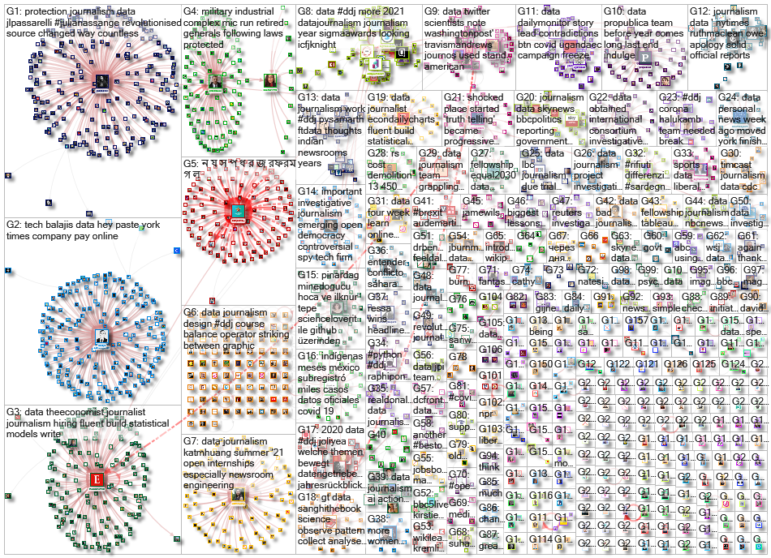Hawaii’s scenery can be breathtaking, with cliff-rimmed white-sand beaches and surf-worthy waves. But our NodeXL #ddj mapping (Dec. 28-Jan. 3) found ProPublica highlighting dramatic erosion of the island state’s beaches over the past century. Also in this edition, we feature an interactive graphic to calculate the time to achieve COVID-19 herd immunity based on the US vaccination rate, a global vaccine distribution tracker, Federica Fragapane’s visualization of stolen paintings, and a compilation of 2020’s best data visualization lists.
Hawaii’s Disappearing Beaches
Three of Hawaii’s major islands, Oahu, Maui, and Kauai, have lost nearly one-quarter of their beaches in the last century. ProPublica examines one of the reasons behind this: Scientists say seawalls and other barriers erected by wealthy homeowners are the primary cause of coastal erosion. Oceanfront property owners are getting around a government “no tolerance” policy toward new seawalls by exploiting an array of loopholes. The piece includes an interactive to explore which properties received permits to keep existing shoreline seawalls — or to build new ones — within the past 20 years.
Jeez the presentation, visuals on this piece by @ngusletter & @sophiecocke is stunning. What a rad way to tell this story. https://t.co/2Aavg1dxau
— Kyle Hopkins (@kylehopkinsAK) January 1, 2021
Stolen Paintings
Using data from Britannica and Wikipedia, designer Federica Fragapane created a data visualization related to the theft of 40 paintings from museums since the 1900s. For each incident, she included information on the painter, year of the theft, whether the painting has been recovered, as well as other works stolen from the same museum.
40 stolen paintings—my latest #dataviz for @La_Lettura is now on @Behance: https://t.co/EbgULBdOpX#Datavisualization #infographic #ddj pic.twitter.com/VcsVREbEbG
— Federica Fragapane (@fedfragapane) December 23, 2020
Is the US Vaccinating Fast Enough?
Harry Stevens, a graphics reporter at The Washington Post, created an interactive graphic with adjustable sliders to calculate the time required to reach herd immunity in the US based on the COVID-19 vaccination rate. His interactive was inspired by a tweet from Dr. Leana S. Wen, a practicing emergency physician, that explained the math of COVID-19 vaccinations.
A helpful interactive graphic to calculate the time to herd immunity, by @Harry_Stevens @PostGraphics https://t.co/lCjFtrOO5H
It's clear we need 2-3 million people vaccinated per day (w/ 2nd dose) to get there in <8 months.
Prior infections (w/o vaccine) may help accelerate pic.twitter.com/Cijoj41PTw— Eric Topol (@EricTopol) December 30, 2020
Vaccine Distribution Tracker
Last month, Bloomberg started tracking the development timeline of nine of the most promising COVID-19 vaccines around the world, from trial to market stage. It has now updated the tracker to monitor the number of vaccinations given globally. More than 15.9 million doses in 37 countries have been administered to date.
This is how things stand at this moment.
Link to interactive: https://t.co/d4ulLAMJOI pic.twitter.com/Fzwjs45vNr
— Bloomberg Graphics (@BBGVisualData) January 5, 2021
2020’s Best Data Visualization Lists
Wondering if you missed any great maps, charts, graphics, and visual stories last year? Data journalist Maarten Lambrechts created a master compilation of the best data visualization lists of 2020, showcasing great works by newsrooms such as The New York Times, FiveThirtyEight, The Wall Street Journal, Reuters, and others. Disclaimer: It also includes GIJN’s own Top 10 Data Journalism for 2020 list.
Yes, it's that time of the year: here is the 6th edition of my List of Data Visualisation Lists! https://t.co/FN0ybafNtk pic.twitter.com/fYKNHIZw7x
— Maarten Lambrechts (@maartenzam) December 22, 2020
Inequality in Air Pollution
The New York Times examined the lives of two children, Monu and Aamya, who live just a few miles from each other in the Indian capital, New Delhi. Using cameras and air quality monitors, the team tracked the level of pollution both children are exposed to over the course of a single day. It found that Monu, whose family lives in a hut in a slum, was breathing in four times as much pollution as Aamya, who comes from an upper-middle-class family living in a wealthier neighborhood. Read a summary of the NYT’s findings in this tweet thread and its research methodology here.
Great use of data visualisation to tell a powerful story on pollution inequality. Well done @nytimes
Who Gets to Breathe Clean Air in New Delhi? https://t.co/ICsCJEEvpR
— Vishwajeet Singh (@vishy0805) January 3, 2021
California’s New Laws
Hundreds of new laws in California took effect at the start of this year, covering issues ranging from COVID-19 guidelines and health care to criminal justice and racial equity. The Los Angeles Times compiled a handy list of the new regulations, sorted by category, to help the public get acquainted with the new rules.
This list is such a public service and I'm thrilled to see it's now in the very capable hands of @phihado – look at that sticky nav!! https://t.co/iwLYEwTBFW
— Priya Krishnakumar (@priyakkumar) January 1, 2021
Making Coronavirus Data Personal
How is a society affected by the coronavirus pandemic? The extent can be difficult to comprehend when the global case figures are in the millions. Neue Zürcher Zeitung, a Swiss German-language daily newspaper, reimagined the effect the virus has had on the Swiss population by illustrating what the figures would look like in a 100-person strong residential community, dubbed the Corona House.
We are all affected by the #pandemic. But in the daily flood of numbers, the extent of it is often difficult to grasp. How did the #coronavirus affect the lives of people in Switzerland, if the country were a house with 100 residents? https://t.co/SWxykZpMFn pic.twitter.com/VHAlVpIdVN
— Adina Renner (@adinarenner) December 22, 2020
COVID-19 Data Journalism Roundup
COVID-19 dominated the headlines and the works of data journalists in 2020. The team at DataJournalism.com picked 10 of the most inspiring coronavirus-related data stories they had seen last year, featuring two GIJN member organizations — Africa’s Data Journalism Alliance Against COVID-19, which was supported by the US-based Pulitzer Center, and the data projects on Pandemic medical supplies and disinformation, created by Peru’s Ojo Público.
2020 has been an important year for #datajournalism. #COVID19 has shown the potential for collaborating with other disciplines. To bring the year to an end, we've highlighted 10 #data stories that made an impact. Give it a read: https://t.co/0XeUaCVtZp #dataviz pic.twitter.com/MZXOF4xqHp
— DataJournalism.com (@datajournalism) December 23, 2020
Missing Women in Mexico Project Wins Funding
Last November, we highlighted an opportunity to win US$10,000 in data journalism funding and training for a Latin American newsroom offered by Microsoft and the Knight Center for Journalism in the Americas. The winner has now been announced; it’s a project investigating thousands of cases of missing women in Mexico, spearheaded by journalist Itxaro Arteta from Animal Político.
A #data #journalism project on missing women in Mexico, led by @iartetam of @Pajaropolitico, wins @Microsoft @KnightCenterUT contest for training and funding https://t.co/jleuF4YzDa pic.twitter.com/ohG1nrCoVl
— Knight Center for Journalism (@KnightCenterUT) December 23, 2020
Thanks again to Marc Smith and Harald Meier of Connected Action for gathering the links and graphing them. The Top Ten #ddj list is curated weekly.
 Eunice Au is GIJN’s program manager. Previously, she was a Malaysia correspondent for Singapore’s The Straits Times, and a journalist at the New Straits Times. She has also written for The Sun, Malaysian Today, and Madam Chair.
Eunice Au is GIJN’s program manager. Previously, she was a Malaysia correspondent for Singapore’s The Straits Times, and a journalist at the New Straits Times. She has also written for The Sun, Malaysian Today, and Madam Chair.

